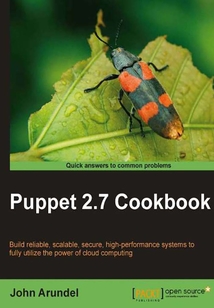舉報 

會員
Puppet 2.7 Cookbook
最新章節:
Index
ThisbookiswritteninaCookbookstyleshowingyouhowtosetupandexpandyourPuppetinfrastructure.Itprogressesthroughdetailedinformationonthelanguageandfeatures,externaltools,reporting,monitoring,andtroubleshooting,andconcludeswithmanyspecificrecipesformanagingpopularapplications.ThebookassumesthatthereaderalreadyhasaworkingPuppetinstallationandperhapshaswrittensomebasicmanifestsoradaptedsomepublishedmodules.ItalsorequiressomeexperienceofLinuxsystemsadministration,includingfamiliaritywiththecommandline,filesystem,andtextediting.Noprogrammingexperienceisrequired.
目錄(119章)
倒序
- 封面
- 版權信息
- Credits
- About the Author
- About the Reviewers
- www.PacktPub.com
- Support files eBooks discount offers and more
- Preface
- What this book covers
- What you need for this book
- Who this book is for
- Conventions
- Reader feedback
- Customer support
- Chapter 1. Puppet Infrastructure
- Using version control
- Using commit hooks
- Deploying changes with Rake
- Configuring Puppet's file server
- Running Puppet from cron
- Using autosign
- Pre-signing certificates
- Retrieving files from Puppet's filebucket
- Scaling Puppet using Passenger
- Creating decentralized Puppet architecture
- Chapter 2. Monitoring Reporting and Troubleshooting
- Generating reports
- E-mailing log messages containing specific tags
- Creating graphical reports
- Producing automatic HTML documentation
- Drawing dependency graphs
- Testing your Puppet manifests
- Doing a dry run
- Detecting compilation errors
- Understanding Puppet errors
- Logging command output
- Logging debug messages
- Inspecting configuration settings
- Using tags
- Using run stages
- Using environments
- Chapter 3. Puppet Language and Style
- Using community Puppet style
- Using modules
- Using standard naming conventions
- Using embedded Ruby
- Writing manifests in pure Ruby
- Iterating over multiple items
- Writing powerful conditional statements
- Using regular expressions in if statements
- Using selectors and case statements
- Testing whether values are contained in strings
- Using regular expression substitutions
- Chapter 4. Writing Better Manifests
- Using arrays of resources
- Using define resources
- Using dependencies
- Using node inheritance
- Using class inheritance and overriding
- Passing parameters to classes
- Writing reusable cross-platform manifests
- Getting information about the environment
- Importing dynamic information
- Importing data from CSV files
- Passing arguments to shell commands
- Chapter 5. Working with Files and Packages
- Making quick edits to config files
- Using Augeas to automatically edit config files
- Building config files using snippets
- Using ERB templates
- Using array iteration in templates
- Installing packages from a third-party repository
- Setting up an APT package repository
- Setting up a gem repository
- Building packages automatically from source
- Comparing package versions
- Chapter 6. Users and Virtual Resources
- Using virtual resources
- Managing users with virtual resources
- Managing users' SSH access
- Managing users' customization files
- Efficiently distributing cron jobs
- Running a command when a file is updated
- Using host resources
- Using multiple file sources
- Distributing directory trees
- Cleaning up old files
- Using schedules with resources
- Auditing resources
- Temporarily disabling resources
- Managing timezones
- Chapter 7. Applications
- Managing Apache servers
- Creating Apache virtual hosts
- Creating Nginx virtual hosts
- Creating MySQL databases and users
- Managing Drupal sites
- Managing Rails applications
- Chapter 8. Servers and Cloud Infrastructure
- Deploying a Nagios monitoring server
- Building high-availability services using Heartbeat
- Managing NFS servers and file shares
- Using HAProxy to load-balance multiple web servers
- Managing firewalls with iptables
- Managing EC2 instances
- Managing virtual machines with Vagrant
- Chapter 9. External Tools and the Puppet Ecosystem
- Creating custom Facter facts
- Executing commands before and after Puppet runs
- Generating manifests from shell sessions
- Generating manifests from a running system
- Using Puppet Dashboard
- Using Foreman
- Using MCollective
- Using public modules
- Using an external node classifier
- Creating your own resource types
- Creating your own providers
- Index 更新時間:2021-04-02 18:20:24
推薦閱讀
- 中文版SketchUp 2022完全實戰技術手冊
- 做好PPT就靠這幾招:圖解力+吸引力+說服力
- 中文版AutoCAD 2015實用教程
- 中文版SolidWorks 2015技術大全
- Spring Security 3
- MySQL Admin Cookbook LITE: Configuration, Server Monitoring, Managing Users
- 斯科特·凱爾比的零基礎攝影后期課 Lightroom數碼照片調修技法
- ASP.NET MVC 2 Cookbook
- 從零開始:Photoshop工具詳解與實戰
- 中文版CorelDRAW X7基礎培訓教程
- AutoCAD 2019中文版實戰從入門到精通
- Joomla! 1.5 JavaScript jQuery
- SolidWorks 2015中文版機械設計從入門到精通
- AutoCAD 2010 建筑設計與制作技能基礎教程
- SQL編程基礎(原書第3版)
- PHP jQuery Cookbook
- 中文版3ds Max案例與實訓教程
- Power BI數據可視化從入門到實戰
- Illustrator 2020實用教程
- Python量化交易實戰
- PowerPoint圖文演示技術(全彩微課版)
- Photoshop CC 2019實戰從入門到精通
- Unreal Engine 4 特效設計必修課
- Lightroom照片處理實戰秘技250招
- Greenplum企業應用實戰
- Drupal 6 Search Engine Optimization
- 3ds Max 2011基礎項目實踐教程
- IBM Lotus Sametime 8 Essentials: A User's Guide
- 中文版Photoshop CS6照片處理500例
- SOA Cookbook

